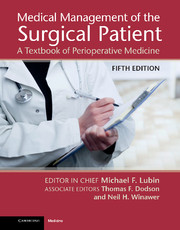Book contents
- Frontmatter
- Dedication
- Contents
- List of Contributors
- Preface
- Introduction
- Part 1 Perioperative Care of the Surgical Patient
- Section 1 General
- Chapter 1 Anesthesia management of the surgical patient
- Chapter 2 Specialized nutrition support in the surgical patient
- Chapter 3 Preoperative testing
- Chapter 4 Medication safety for surgical patients
- Chapter 5 Informed consent and decision-making capacity
- Chapter 6 Ethical considerations in the surgical patient
- Chapter 7 Perioperative pain management
- Chapter 8 The medical consult
- Section 2 Cardiology
- Section 3 Hypertension
- Section 4 Pulmonary
- Section 5 Gastroenterology
- Section 6 Hematology
- Section 7 Infectious disease
- Section 8 Renal disease
- Section 9 Endocrinology
- Section 10 Rheumatology
- Section 11 Neurology
- Section 12 Surgery in the Elderly
- Section 13 Obesity
- Section 14 Transplantation
- Section 15 Psychiatric Disorders
- Section 16 Peripartum Patients
- Part 2 Surgical Procedures and their Complications
- Index
- References
Chapter 1 - Anesthesia management of the surgical patient
from Section 1 - General
Published online by Cambridge University Press: 05 September 2013
- Frontmatter
- Dedication
- Contents
- List of Contributors
- Preface
- Introduction
- Part 1 Perioperative Care of the Surgical Patient
- Section 1 General
- Chapter 1 Anesthesia management of the surgical patient
- Chapter 2 Specialized nutrition support in the surgical patient
- Chapter 3 Preoperative testing
- Chapter 4 Medication safety for surgical patients
- Chapter 5 Informed consent and decision-making capacity
- Chapter 6 Ethical considerations in the surgical patient
- Chapter 7 Perioperative pain management
- Chapter 8 The medical consult
- Section 2 Cardiology
- Section 3 Hypertension
- Section 4 Pulmonary
- Section 5 Gastroenterology
- Section 6 Hematology
- Section 7 Infectious disease
- Section 8 Renal disease
- Section 9 Endocrinology
- Section 10 Rheumatology
- Section 11 Neurology
- Section 12 Surgery in the Elderly
- Section 13 Obesity
- Section 14 Transplantation
- Section 15 Psychiatric Disorders
- Section 16 Peripartum Patients
- Part 2 Surgical Procedures and their Complications
- Index
- References
Summary
Few aspects of healthcare involve as much simultaneous interaction by different physicians as the management of the patient undergoing surgery. At a minimum, the primary care provider, surgeon, and anesthesiologist form a team of physicians, all of whom bring a different perspective and expertise to the care of the patient. As the medical intensity of patients increases, there is also an expanding number of community-based and hospital-based specialty physicians and hospitalists actively involved in this process.
The intersection of the primary care provider and the anesthesiologist first occurs when the surgeon schedules a patient for surgery. At that point the series of events that culminates in medical evaluation, anesthetic assessment, and perioperative management starts. This chapter will begin with that aspect of preparation of the patient for elective surgery. The greatest detail is spent in this area as this is where, by far, the greatest overlap of expertise and communication occurs. The remainder of the chapter will then briefly cover the standard issues involved in perioperative management. These comments are not so much geared to make the primary care provider an expert in the field but are more designed to provide some familiarity with the environment into which the patient is going. It is assumed that detailed information about anesthesia care is provided directly to the patient by the anesthesia provider and/or preoperative systems.
- Type
- Chapter
- Information
- Medical Management of the Surgical PatientA Textbook of Perioperative Medicine, pp. 3 - 12Publisher: Cambridge University PressPrint publication year: 2013

